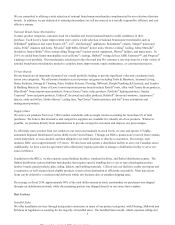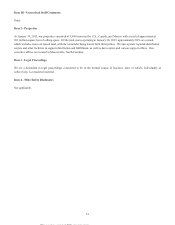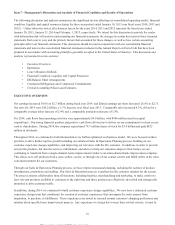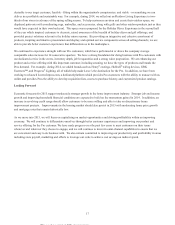Lowe's 2014 Annual Report Download - page 18
Download and view the complete annual report
Please find page 18 of the 2014 Lowe's annual report below. You can navigate through the pages in the report by either clicking on the pages listed below, or by using the keyword search tool below to find specific information within the annual report.We may not be able to realize the benefits of our strategic initiatives focused on omni-channel sales and marketing presence if
we fail to deliver the capabilities required to execute on them.
The success of our strategic initiatives to adapt our business concept to our customers’ changing shopping habits and demands
and changing demographics will require us to deliver large, complex programs requiring different skill sets and capabilities
than were required by our management, employees and contractors in the past to achieve our objectives. They will also require
more integrated planning, initiative prioritization and program sequencing. Our leadership development program for our
managers at all levels is focused on aligning processes for corporate strategy, business unit strategy and integrated planning to
drive alignment, execution and delivery of solutions, including timely delivery and functionality of new technology solutions.
Our strategic initiatives will require new competencies in many positions, and our management, employees and contractors will
have to adapt and learn new skills and capabilities. To the extent they are unable or unwilling to make these transformational
changes, we may be unable to realize the full benefits of our strategic initiatives and expand our relevant market access. Our
results of operations, financial condition, or business prospects could also be adversely affected if we are unable to attract and
retain additional personnel at various levels of the Company who have the skills and capabilities we need to implement our
strategic initiatives and drive the changes that are essential to successfully adapting our business concept in the rapidly
changing retailing environment.
As customer-facing technology systems become an increasingly important part of our omni-channel sales and marketing
strategy, the failure of those systems to perform effectively and reliably could keep us from delivering positive customer
experiences.
Access to the internet from computers, tablets, smart phones and other mobile communication devices has empowered our
customers and changed the way they shop and how we interact with them. Our website, Lowes.com, is a sales channel for our
products, and is also a method of making product, project and other relevant information available to them that impacts our in-
store sales. In addition to Lowes.com, we have multiple affiliated websites and mobile apps through which we seek to inspire,
inform, cross-sell, establish online communities among and otherwise interact with our customers. Performance issues with
these customer-facing technology systems, including temporary outages caused by distributed denial of service or other cyber-
attacks, or a complete failure of one or more of them without a disaster recovery plan that can be quickly implemented could
quickly destroy the positive benefits they provide to our home improvement business and negatively affect our customers’
perceptions of Lowe’s as a reliable online vendor and source of information about home improvement products and services.
Our financial performance could suffer if we fail to properly maintain our critical information systems or if those systems are
seriously disrupted.
An important part of our efforts to achieve efficiencies, cost reductions, and sales and cash flow growth is the maintenance and
ongoing improvements of our existing management information systems that support operations such as inventory
replenishment, merchandise ordering, transportation, receipt processing and product delivery. Our financial performance could
be adversely affected if our management information systems are seriously disrupted or we are unable to maintain, improve,
upgrade, and expand our systems.
Our business and our reputation could be adversely affected by the failure to protect sensitive customer, employee, vendor or
Company information or to comply with evolving regulations relating to our obligation to protect our systems and assets and
such information from the threat of cyber-attacks.
Cyber-attacks designed to gain access to sensitive information by breaching mission critical systems of large organizations are
constantly evolving, and high profile electronic security breaches leading to unauthorized release of sensitive customer
information have occurred in recent years with increasing frequency at a number of major U.S. companies, including several
large retailers, despite widespread recognition of the cyber-attack threat and improved data protection methods. Despite our
continued vigilance and investment in information security, we may be unable to adequately anticipate or prevent a breach in
our systems that results in the unauthorized release of sensitive data. Should this occur, it may have a material adverse effect on
our reputation, drive customers away and lead to financial losses from remedial actions, or potential liability, including possible
punitive damages. A security breach resulting in the unauthorized release of sensitive data from our information systems could
also materially increase the costs we already incur to protect against such risks. In addition, as the regulatory environment
8
This proof is printed at 96% of original size
This line represents final trim and will not print
























